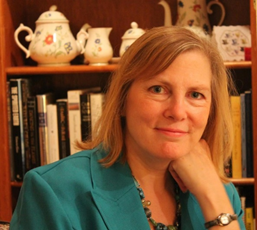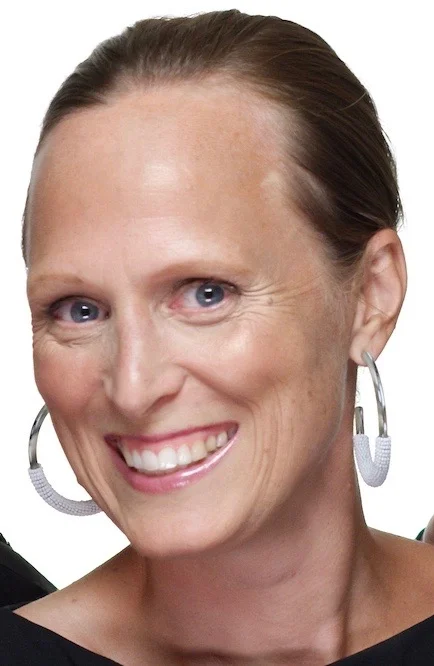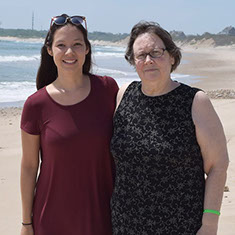On September 28th, as part of HUBWEEK 2016, Health Story Collaborative hosted one of our Healing Story Sessions at the Paul S. Russell, MD, Museum of Medical History and Innovation. Healing Story Sessions are live storytelling events founded on the belief that story sharing is healing. In preparation for these sessions, we work closely with participants to construct their stories of illness and healing and to become comfortable sharing their stories in spoken word in front of an audience. Typically, story sharers invite a group of community members to witness their stories in a safe and supportive environment. On September 28, in a departure from our norm, we opened the event to the public.
We had three courageous story sharers. In the coming weeks, we will feature the written stories and the accompanying videos from the live event. We encourage you to read and watch.
As our first feature, we bring you Michele Foley. Michele is living with Stage 4 Melanoma. Her story is brave and beautiful. For the event, she shared the stage with her son, Andy, currently a second year Harvard Medical School student. Stay tuned for his story next week.
Good Mornin’ Glory
By Michele Foley
Andrew reminds me of a story I often forget. It is a story of becoming stronger, forgiving myself, laughing at myself, connecting with others. He reminds me -with his questions and focused listening -how sacred it is to share in someone’s story. I thank him for his sublime attention to my medical experience over these years. His willingness to be so involved inspires action within me, and action from others. He wraps his positive energy around me—and he might not know till now, how he has held me together and kept me walking forward.
2010 At crossroads in my life. Our answer to the empty nest? My husband and I take flight ourselves- new college jobs in the Southern Allegheny Mountains of rural Pennsylvania. Initially empty nest for me is filled with a sense of loss for what I called home: 28 years of memories with our three sons, close friends, a high school teaching routine. Change evokes a gut-wrenching ache. Where is everyone I have been centered on for the last twenty-nine years? I am off-balance. Why is my reaction to withdraw and isolate myself? Why cling to the familiar, and long for what has been? “Give yourself time,” my sister reminds me. Time to listen, pay attention, so I start to open my eyes to my new world. I drive back and forth every day, up and down the Cresson Summit, 2,430 feet above sea level. I notice massive cloud formations, September blue skies, sunsets, stars, and moonlight with magnificence like never before. College chapel bells bless each hour, adding sounds familiar from my neighborhood as a child that bring comfort. Let this new adventure be an example of what I want to tell others: get up, get out and walk boldly into your life. “Shine on,” those chapel bells sing. And so we do. Poet Nina Bogan’s lines capture my feeling then:
When I walked up the road, the string sack
Heavy on my arms, I thought
That my legs could carry me anywhere,
Into any country, any life…
One year later I am rambling back on the train from NYC to the college, to my new home. Sent to the big city to attend the JED Foundation Gala, I finish with my five hours of fun and fancy. I return to work in the train’s quiet car. Answering a call from the surgeon’s office, I step out between shifting train cars, struggling to keep my balance, and lean on the aluminum wall to take notes. I cannot hear the medical assistant’s voice and ask her to repeat and spell the results. I copy her exact words on a remnant scrap and keep it in my hand, returning to my seat. I struggle to keep my inner balance. This can’t be good. Exceedingly rare neoplastic cells positive for Melanin A, HMB-45, S-100 features consistent with metastatic deposit. Malignant metastasized melanoma. No. Not this, not now. I am just into my new life. If I don't say it aloud, look at the words scribbled on the paper, I might not have it. I will deal with this myself. Alone. No one else needs to get upset or derail their lives. Not so much sorry for myself, I feel sorry that I must begin to tell family about this. Once I disclose the diagnosis, I will have no control over others’ reactions. I don’t want to be the reason my husband is upset, my sons are sad.
I return the next day to have sutures removed. Maybe there is a mistake in the lab report. Staff stare at me as if I am dead. Even the surgeon gives me a hug, “god blesses” me, hopes I have my “things in order.” I can't leave fast enough. I bolt to my car, roll down the windows in the sweltering Ford, sit quietly, and notice bells dreadfully tolling the noon hour from the nearby rundown cathedral. “For whom the bells tolls, it tolls for thee.” Doomed, done, those bells keep telling me.
Surgery tolls. Driving to the hospital, I command my husband a la ultimatum. “If they can remove the cancer completely, but need to take my leg--fine. If they go in, the cancer is everywhere, lymph nodes and all, keep the leg intact and let it be.” Not long ago I felt “my legs could carry me anywhere.” Foolish to think I am in command. Come, Holy Spirit, fire me up. Keep me warm as I shiver pre-op. I ask for boldness of heart, I ask for patience with the unfolding of life, I ask for joy. Come what may. Good thing I memorized it. Pre-op needles in, monitors beeping, it all signals solemnity.
Post op results – Tumor exceedingly rare. We have never seen this (tumor type) before. So I am “one in a million?” Ah, it makes my stomach ache. Can’t this be ordinary? Please no, not exceedingly rare.I like to think I am one in a million but not like this!
My bubbly Brazilian surgeon exudes optimism and hope. I try to share his outlook. It lasts three days. Floodgates open when, with water from the shower, I make my first attempt at loosening the bandage. There it is, a twelve-inch gash spanning my left outer thigh. Raw, jagged, unfamiliar- I begin to sob. My life-long optimism betrayed by this. It felt like I was being mocked--ha-- “my legs could carry me anywhere.” I was going nowhere. I was heading straight to the Interferon lab.
“Give yourself time to heal,” my son Matt coaches. The scar healed; I started to fall apart, needing constant reassurance that all of the cancer was removed, margins clear and everything under control. Guaranteed, right?
Patient patient I am not; setting new goals helps. I will walk again without a hitch. I will wear long pants forevermore. I will never go to the beach again, only to be mocked by the sun. I, I, I, now seems silly. Pace myself? Who am I kidding? My body will let me know. Let go. No control. Let it, allow it, flow with it. Practice it. Make it my practice. Learn again. Again and again. Work to get my balance back. Identify what gives me strength, go after it. Slow and steady. “Take your time,” my husband reminds me. This is not a race.
2011. 2012. 2013. 2014. 2015 No evidence of metabolically active recurrent or metastatic disease. With each checkup I move a little closer to lightness of being. The remarkable feeling of seeing reports that deem organs “unremarkable” brings a smile. My ordinary life swings back with tutoring, teaching, editing. I act as if the summer of surgeries is a distant past. Deep within though there’s the tolling. I am aware of time ticking both in my head and heart. It counts the time I may have with my people; it counts the time until the next scan. I try to remind myself: Be open. Be alive. Pick up what is right there in front of you--this gift!
2015 Routine PET scan reveals spot on left lower lung. I feel that shot to the gut again. Unfortunately default mode kicks in. I go to clinic appointments alone. I go to biopsy alone. My heart pounds. My head throbs. Tears well up but not out. Metastatic melanoma Stage IV. Medical plan RadVac. It is on the move, in my bloodstream, everywhere. I go to radiation appointments alone. My arms hurt. This is too much for me to carry. Our son Matt is getting married to Katie in a few weeks. Wedding bells should be ringing, not the tick tock, chime, timer, bells tolling that my time is up. Off-balance. I steel myself. I will carry this latest news myself.
When will I learn?
I tell my people. It is happening to all of us, our son, Andrew reminds me. We will walk this next part together.
After two weeks of radiation and one Pembrolizumab treatment, wedding bells chime! Our son Tommy, reminds me to feel all the love that fills, overflows in our home. I stand off to the side looking at our yard filled with a circle of love-all of us enjoying a summer eve together. I listen: belly laughing and belching; crickets’ song and sounds of kids. Listen hard. What a fool I’d be to isolate myself from all of this wonder-filled-ness. Balanced and buoyed. I gather strength, more than I ever knew from those who love me. It is the ordinary time we spend that is the best: taking a walk, prepping a meal, pulling weeds in the yard, collecting sweetie tomatoes, icing up a glass of cold water and surprising the other with it. Such comfort in the beautiful ordinary day.
“What’s good?” my son asks, just to remind me.
Along the way, it has been a challenge to find the energy to always begin again: new treatment, new clinics, new procedures, new side effects, new allergies, new story –that is the norm. Gather again and again the beginner’s mind. Inner balance is what I am spending time on, and implementing a plan to keep strong. I begrudgingly take time to attend to symptoms of the pembrolizumab treatment. My sister chimes in, “Be as good to yourself as you are to me, to others.” Only after that can I spin into the ordinary day: tutoring, editing, walking, practicing yoga, humming, being grateful. I am the luckiest person on the planet.
I have imposed only three goals this time around. One, I limit my thought/conversation about the melanoma on an ordinary day to max ten minutes. This includes internet research, telephone conversation, complaining to family. The timer is set and when it chimes--DONE. Two, taper back on daily work--some tutoring, editing continues. Three, tend to the wellness to keep balanced. I admit all that attention makes me weary. No shortcuts. Fresh fruit and veggies, green tea, yogurt, kefir, beans, broth; then start over again shopping and preparing. A cup of tea, a homemade blueberry muffin, good company: today’s recipe for feeling fully alive.
There are a few aspects that I am working on these days.
*What does life as “normal” after cancer look like? Loved ones just want to see the old “me” back as a sign that all is well. Gone, she has moved on
* In my quest to pay more attention to detail, I try to work and stay ahead of whatever symptom is presenting, no matter how small. This self-compassion and self-coaching has been helpful in keeping my brain focused on a plan to affect a better outcome.
* I have pledged full disclosure always to family (in so doing I model what I hope will be same for us all).
* I am terrible about asking for something for myself, so that is my subset of full disclosure. Not edit, sugar coat, back pedal, apologize, or cry. Name it; claim it and move through it. This is applicable from extremes: craving butter almond ice cream to refusing to go to the next scheduled treatment.
2016 Currently, I am on hold after 8 Pembrolizumab infusion treatments. Last scans just in August were straightforward. No new evidence of metastatic disease in the chest, lower left lobe. Nodular component near the medial margin measures 0.9cm and is unchanged since 5/16/2016. There are no new pulmonary nodules. Like Poetry.Details regarding this type of melanoma say it is least receptive to targeted drug therapy. Darn again, that one in a million! The plan is to monitor and report symptoms to clinic every three weeks. No travel. Follow up PET scan. It feels good putting a bit of distance between clinic visits now. So I approach this interim as time to get my second wind. I want to be present to the here (and hear) and now, taking it all in—saturating my sense as I pause often during an ordinary day. I continue to pray to have the guts to be able to “carry” whatever comes next. Not really sure if that points to me or to those I love. No matter. Lately a sense of great freedom is emerging - having faced a bit of darkness. How to get back a bit of the “my legs can carry me anywhere?” Get up, get out and walk boldly into your life. Begin to hit the tennis ball, plant basil, bake Irish soda bread, dab on lavender, walk two-a-days, occasionally buy a good cup o’coffee.
In a monumental turnabout, I have moved from “I have to take care of everyone” to “Good morning glory. Let me gather my strength and be of help today.” I am humming along with guarded optimism, knowing the limits to that I can control. So I have retired from some of my favorite avocations: running my brother’s life, offering childrearing advice, meddling as the smother-in-law, badgering students about Thirsty Thursday when a paper is due Friday, forwarding TED talks to 30 on my contacts list, arguing with my hubby.
Postscript
As the Joan Didion quote says, “We tell ourselves stories in order to live.” The story I tell myself is to get up, get out, and walk boldly into life. Over and over again I realize how lucky I am. Andrew shared with us a quote during his first week at Harvard Medical School: “ Life is short and we have never enough time for gladdening the hearts of those who are travelling the journey with us. Oh be swift to love, make haste to be kind”. This is my avocation now.
This narrative unearthed so much that was unspoken, tucked away, intentionally forgotten. Wrestling with, loving, crying, remembering, speaking, listening, forgetting, and forgiving—all messy indeed. It has been cathartic and calls me to be courageous. As the psalm says, for what has been, thanks. For what is to come, yes.
































